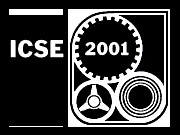Challenges and Achievements in Software Engineering (CHASE)
Thursday, May 17, 2001
Track chairs:
Gregor Engels and
Wilhelm Schäfer,
University of Paderborn, Germany
Software Engineering is still on the way to become a true engineering discipline with firm and well-understood foundations. During the last two decades, researchers as well as practitioners worked hard to identify and to develop the right techniques for effective and successful software engineering processes. Due to several reasons, as, e.g., educational background or time and budget resource constraints, academic researchers on the one hand and industrial practitioners on the other hand followed different pathes in developing these software engineering techniques.
The objective of the CHASE track is to contrast an industrial perspective with an academic perspective, in order to identify the main achievements of the past, i.e., the state-of-the-art, and to identify the main challenges for the future. This will be the base for drawing a joint road map for future work as result of the CHASE track.
The presentations and discussions focus on two important topics within software engineering, i.e., Process-centered Software Engineering Environments (PSEE) and the area of specification and modeling of software systems. Four distinguished and well-known persons have been invited to present their perspectives. On the topic of PSEEs, Bob Balzer and Volker Gruhn, both with an academic as well as industrial background, present their perspectives. On the topic of specification and modeling, Manfred Broy presents his academic, scientifically based perspective, while Bran Selic reports about an industrial perspective.
The final session in the CHASE track will report about a project which approaches the issue of achievements in particular on a broader scale than the two previous sessions. The Impact project is identifying major results in software engineering research which had a broad impact on industrial development processes. It will provide concise summaries of these results and describe the particular improvements which were based on these results. The first areas identified by the Impact project will be described in more detail in the last CHASE session.
S24
Process-Centered Software Engineering Environments
Session chair:
Wilhelm Schäfer,
University of Paderborn, Germany
Process-Centered Software Engineering Environments: Academic and Industrial Perspectives
Robert Balzer,
Teknowledge Corporation, USA; and
Volker Gruhn,
University of Dortmund, Germany
Software engineering environments have a history of about two decades. Early environments provided support for small fragments of the software process (usually focusing on programming-in-the small). Then there was a trend towards support for more complete software processes (from early phases like requirements analysis and design down to testing and configuration management). Ten years ago the notion of process-centered software engineering environments initiated a new field in software engineering: software process research. The key idea was to use a model of a software process as input parameter for a software engineering environment. The environment was supposed to "behave" in accordance to the process model. Some aspects of this vision became true, others turned out to be of little practicability.
Thursday, May 17, 2001; 8:30 a.m.–10:00 a.m.
S32
Specification and Modeling
Session chair:
Gregor Engels,
University of Paderborn, Germany
Specification and Modeling: An Academic Perspective
Manfred Broy,
Technical University of Munich, Germany
The specification and modeling of software systems, of their aspects, and their development processes is at the heart of software engineering. Over the years, we have achieved a much deeper and more comprehensive understanding of software and its models as a basis for its specification. However, there is still a way to go to make sure that all we know right now is transferred into practice, and that all we do not understand so far is investigated in depth. The goal is a tractable scientific basis for modeling and specification in programming, software and system engineering and its employment in engineering methods.
Specification and Modeling: An Industrial Perspective
Bran Selic,
Rational Software Canada Corporation, Canada
When it comes to industrial software development, the use of models is, at best infrequent and, in the vast majority of cases, completely absent. This dearth of models and modeling techniques in software engineering is one of the main reasons why it is often claimed—with some validity—that it does not constitute a "proper" engineering discipline.
Considering that some of today’s software systems are probably the most complex machines built by humanity, this situation is somewhat paradoxical. Not only are such systems extremely intricate, but they are also usually extremely expensive. Models then, particularly formal ones, sound like an obvious solution. Yet, the most common way of developing software in industrial practice is still to build the system in its entirety and then find out if it works using hit and miss techniques such as testing. So why is modeling so infrequent in industrial software development? The reasons can be grouped into accidental ones and fundamental ones.
Thursday, May 17, 2001; 2:00 p.m.–3:30 p.m.
S37
Impact Project
See Impact project panel.
Thursday, May 17, 2001; 4:00 p.m.–5:30 p.m.

